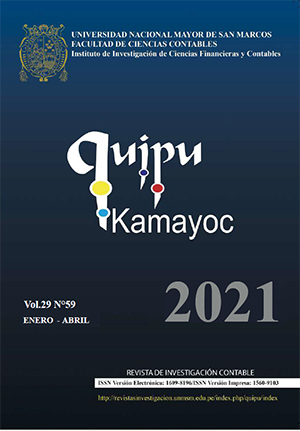Cash conversion cycle and its impact on the liquidity of an industrial company
DOI:
https://doi.org/10.15381/quipu.v29i59.20141Keywords:
Cash cycle, liquidity, rotation, cash, companyAbstract
Objective: To establish the impact of the cash conversion cycle on the liquidity of the industrial company Damar G&L S.A.C of Lima, during 2016 to 2019. Method: The study presented a quantitative approach with a range of cross-sectional correlational, using a non-experimental design. The method used to collect the data was the documentary analysis. As the study population, this research used data from the accounting records of accounts receivable, inventories, and the company’s payable accounts, in which 48 financial monthly statements were structured. Results: The results show that there is a minimal non-significant relationship between the cash conversion cycle and liquidity (Rho = .075, p = .614) corresponding to the periods under study. Furthermore, the independent variable’s indicators, accounts receivable turnover period, inventory turnover period, and accounts payable turnover period, show a weak relationship (Rho = .201, -.267, .086) in the acid test, with a significance level greater than 5%. Conclusion: It is concluded that, during the 2016-2019 period of the company under review, the cash conversion cycle does not directly affect its liquidity.
Downloads
Downloads
Published
Issue
Section
License
Copyright (c) 2021 Patrick Ademir Diaz Cuenca, Jesabel Jesús Ramón Martínez

This work is licensed under a Creative Commons Attribution 4.0 International License.
AUTHORS RETAIN THEIR RIGHTS:
a. Authors retain their trade mark rights and patent, and also on any process or procedure described in the article.
b. Authors retain their right to share, copy, distribute, perform and publicly communicate their article (eg, to place their article in an institutional repository or publish it in a book), with an acknowledgment of its initial publication in Quipukamayoc .
c. Authors retain theirs right to make a subsequent publication of their work, to use the article or any part thereof (eg a compilation of his papers, lecture notes, thesis, or a book), always indicating the source of publication (the originator of the work, journal, volume, number and date).






